|
Welcome at Johannes Graf´s Rainbowfish pages
Rainbowfishes
Rainbowfishes? They only live in the fairytale!
This is wrong! They exist, and they are more colorful in rality than in
the fairytale books.
This fish genus is unknown to most aquarium
hobbyists. This is the result from the boring presentation in the pet
shops. Nobody wants small grey fishes for a lot of money.
What´s the reason for this? What´s about Rainbowfishes?
From the beginning:
Leave South America, Asia and eastern
Africa
. The most aquarium fishes come from those regions. Go mentally to a fishy unknown continent called
Australia
. There and in
New Guinea
you find Rainbowfishes and their nearest relatives, the Blueeyes.
Rainbowfishes are members of the Order
Atheriniformes. They developed from marine species and migrated to
fresh water in ancient times. Don´t worry, they are purely
freshwater fishes. But maybe this is kind of a reason they are
different..
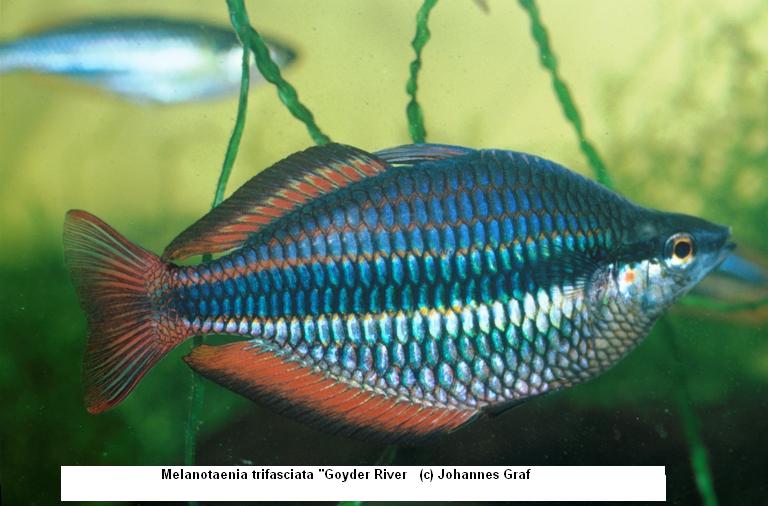
One might think there is so little water in
Australia that fishes can´t live and there are only a few
species. That´s wrong. More than 65 species are currently known
from
Australia
and New Guinea., of which about one third lives in
Australia
. But those counts are outdated in the moment they are written. There
is a ongoing discovery of new species. The reason is that inner
Australia and New Guinea still ave unexplored areas. Most rainbowfish
species are living only in a
Lake
or short part of a River.
The comparatively small number of australian
species is compensated by a fascinating fact. There are more than
thirty color variants from some species. Best example is Melanotaenia trifasciata , the “Jewel Rainbowfish”. Also Melanotaenia splendida as "Overhead species" with the three species M.spl. splendida, M. spl. inornata and M. spl. tatei shows a unbelievable variability.
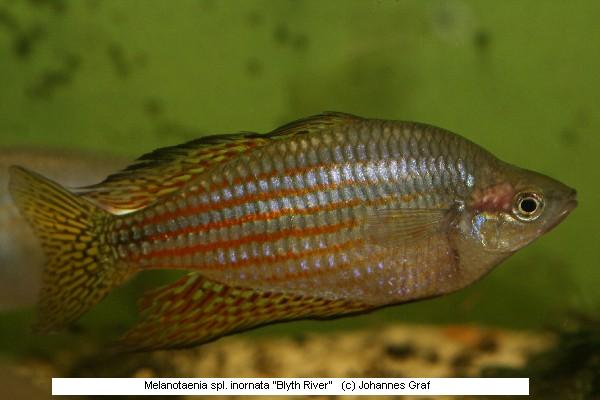
There is another color form in any other River.
And this is the reason why those animals are traded always with the
indication of the original collection place. For example: Melanotaenia splendida splendida "Deepwater Creek". This is the variant form a River called “Deepwater Creek in eastern
Queensland
,
Australia
.
What ist he reason fort his amazing range of variants?
The reason is the last Ice Age. The water level of
the seas have been much lower in those times and the rivers were
connected. The fishes living in have been more or less the same. When
water levels rose with the melting ice, the lower parts of the rivers
were flooded by the sea. A very good demonstration can be found at Sahul Time.
Rainbowfishes could only survive in the upper parts of the rivers and
split up in a lot of isolated populations. Because this is a very young
fish genus, it has a high genetical variability anyway and developed
many morphs that are different in color and body shape.
But – what is so amazing with Rainbowfishes to be better than Guppy, Discus, African Chichlids and what ever?
One reason is the color. It is always changing.
Those fishes have a different color in the morning than in the evening.
Another reason is the choice of species and variants. The impressive,
but non-aggressive mating behaviours are wonderful to see. In most
cases plants are neglected which means that Rainbowfishes can be kept
in nicely planted aquaria.
Keeping Rainbowfishes is easy if some basic rules are followed.
- Buy only healthy fishes. Otherwise you have a bad
start. Watch up for thin ridges, shrinkled bellys, or bad fins. This
can be a indication for fish from mass breeding, too. Those fishes will
not get old and have bad colors.
- Buy only fishes with a clear indication of
origin. There are so few breeding specimens that Hybridisation should
be avoided. Don´t overcrowd your aquarium. They most interesting
species reach 8-12 cm lenght and need enough space to swim. A aquarium
of 80 cm length is a minimum, better one meter.
- Do weekly waterchanges of one third. Most species live in rivers or lakes where water runs through.
- Feed enough, but not too much. Rainbowfishes
are voracious eaters and always want more to eat. Give a vegetal part
of food (Spirulina flakes, boiled peas).
- Don´t feed only flakes. Live and frosted food is good for body´s defences, color and makes them lively.
- Water values not extremely on the acid side.
Rainbowfishes are not Hardwater fishes, but some minerals should be in
there. Levels around 180 ppm with a pH in the neutral or softly
alkaline part are OK. A little add of salt is good, too.
In the following I will shortly describe some
species. But you should introduce yourself with a good book first. I
recommend Gerry Allen´s „Fascinating Rainbowfishes“.
This is still the best book so far, but it is sold out. Dr. Gerry Allen
is by the way the „Guru“ in the Rainbowfish world. He
discovered and described most of the species. There are many
informations in the Internet to find. Be aware of many misinformations
in the internet. See „Link“ page with good rainbowfish
sites.
Pet stores often have only Melanotaenia macculochi, the dwarf Rainbowfish. From this species only some specific color forms are qualified to warm up for Rainbowfishes.
Melanotaenia praecox, the Diamond Rainbow,
has overwhelming colors, a plain neon-blue body and blood-red fins.
This small species is perfect. But there is a big inbreed depression
for many fishes from commercial breeding, so wach out for good fish
from good breeders. The same holds for M. lacustris, a blue-green species of about 12 cm lenght.
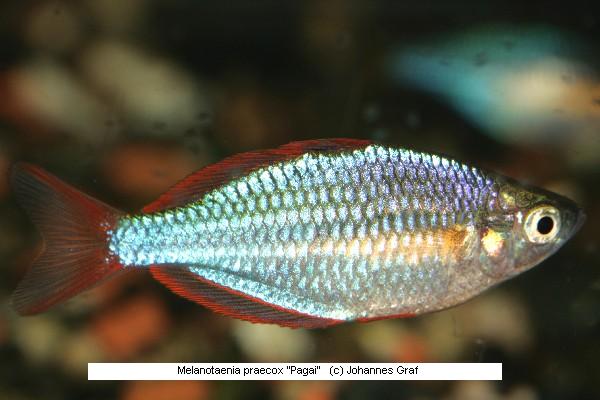
Melanotaenia boesemanii, the Harlequin
Rainbow, can be seen regularily in the trade. If you get good
specimens, this species is wonderful. The front body is blue, the back
part is orange.
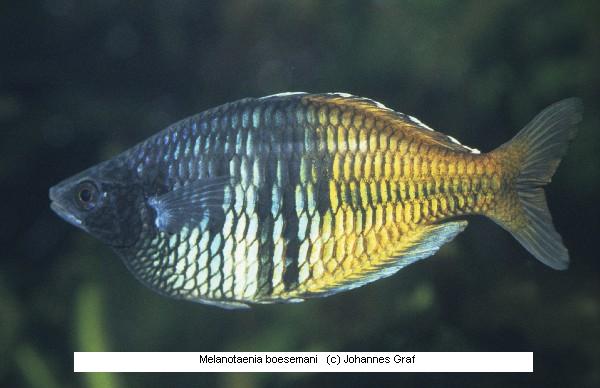
Glossolepis incisus, the salmon red
Rainbowfish, does not show ist colors in the pet store´s
aquariums. This species is flashing red when adult. The most voracious
eater amongst the Rainbowfishes.
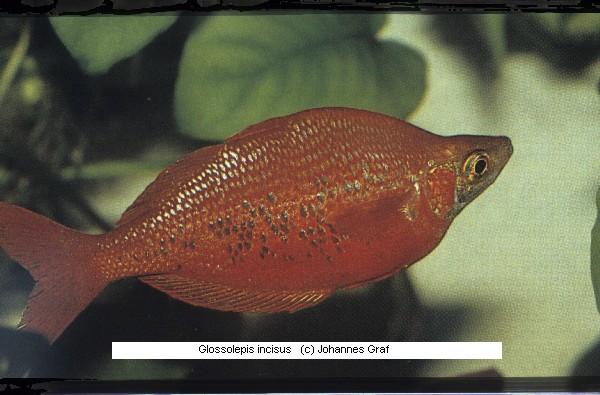
Melanotaenia herbertaxelrodi, the
Lake-Tebera-Rainbowfish, is one of the most spectacular species and
occasionally in trade. Adult males are about 12cm in lenght. The basic
color is yellow, with fins in red and yellow.
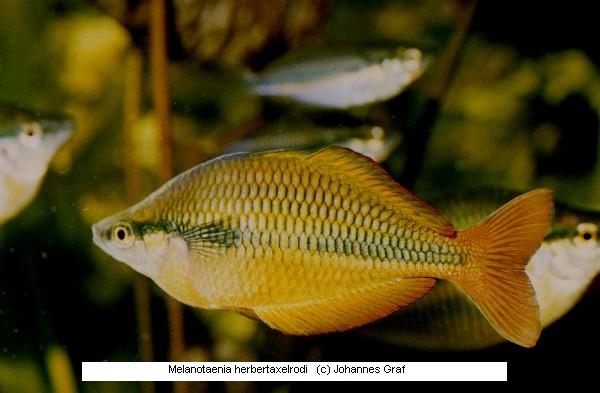
Melanontaenia trifasciata, called
„Jewel Rainbowfish“ is the "Celebrity“ of
Rainbowfishes. There are more than 30 Variants, with high and slender
body types, and every color combination you can think of. The best
known is "
Goyder
River
" or „Guyula“ showing a dark blue body with red lines and red fins with black margins.
Melanotaenia splendida splendida, the
Eastern Rainbowfish
, has also a lot to show. The most beautiful variant comes from
“Deepwater Creek”, showing blue-silver shining scales and
flashing red fins.

Where can I find such fishes in good quality?
Not in the pet store in most cases. The association of Rainbowfish friends is called „IRG“ (www.irg-online.de). Four times per year the magazine “Regenbogenfisch” is issued in German and
Netherlands language
. Amongst very good articles each issue contains a list of young fish offers by the members.
Australia
is home of the ANGFA association which has a very good network and the magazine “Fishes of Sahul”.
Regional pet fish meetings are another good chance
to get hold on rainbowfish bred by hobby breeders. This is a very good
source, as such people take care on their fishes.
Rainbowfish hybrids are sometimes offered, mostly
in the commercial trade. They are coming under phantasy names, such as
“Red Baron” or “Melanotaenia hammeri”. This is
a hybrid between Melanotaenia boesemani and Glossolepis incisus.
Another example is Chilatherina fasciata "Kali Biru", of which the
specimens in the hobby are hybrids between C. fasciata and C. bleheri.
Such Hybrids are sometimes impressive by their color and size (due to
the Hybrid effect). The vast majority of Rainbowfish enthusiasts
doesn´t like such Hybrids. The intention is to keep the species
as they come from the wild. If at all, in any case Hybrids should only
given away with a clear comment on their hybrid status.
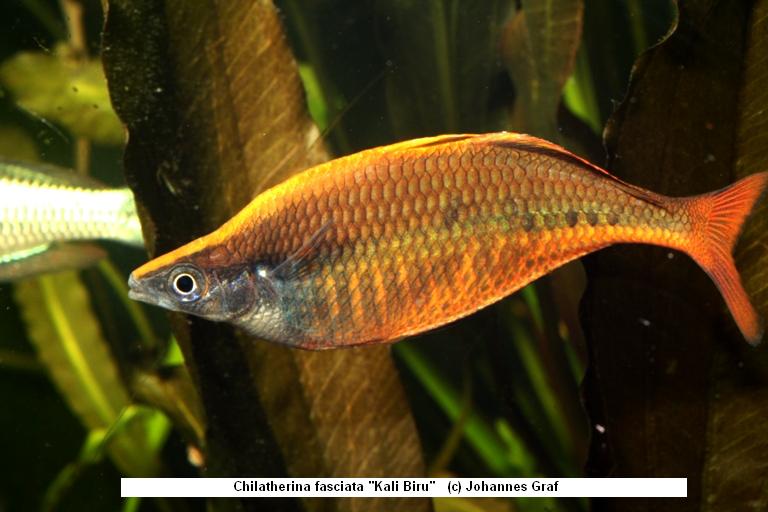
Breeding Rainbows is easy
Provided for this introduction are basic knowledges on the breeding of ornamental fishes.
If Rainbowfishes are kept in a species tank with a
quiet corner planted with floating plants sooner or later fry will
appear. Most Rainbowfish species spawn every day, mostly in the
morning, with the males attracting the females and the pairs spawning
in the plants. The tiny, crystal clear eggs adhere to the plants with
their sticky filament for about 10 days until the fry hatch.
Except for a few species, the adult specimens eat
the fry. This is a completely natural strategy of population control.
But in tight areas of floating plant a few fry will survive. In a good
running Aquarium the fry will find enough microorganisms to eat. The
aquarist can support the fry by giving small amounts of finest powdered
food or Artemia-nauplii, microworms or vinegar eels. This
should be done in the same moment than feeding the adults. If not, the
adults will be attracted to get in the hiding places of the fry. After
the fry has reached a sufficient size, they will leave their hiding
places and meet the group of adults.
This method is in most cases enough to sustain the
population of this Aquarium. In a community tank it will not work. For
a systematic breeding the numbers of fry achieved with this method is
not sufficient.
Inbreeding is a permanent problem in Rainbowfish
breeding, because most species in the hobby go back to a few original
specimens. A group of fishes should be used for a breeding project,
with the group members originating form different sources, if possible.
This keeps the genetical bandwith as broad as possible. A practical
groupsize is 6-10 specimens. The breeding setup can be made in a
60x30x30 cm tank fro the smaller species like M. praecox. Breeding projects for larger species like M. trifasciata
should be done in larger tanks of 80 or 100 cm lenght. When composing
the breeding group, a slight overhang of females is better, because
males often produce high pressure to the females. Several males of the
same size reduce the pressure to the females because the males get a
bit destracted by their hierachy rituals. Such groups can be kept in a
breeding tank permanently.
The breeding tank´s setup is gravel on the
ground (Rainbowfish on blank glass are skittish), a small canister
filter or better a air driven sponge mat filter
and a spawning mopp. Once a week a regular water change of 20% should
be done. The fresh water shouldn´t be too cold, many species are
susceptible to heavy variations in temperature.
A spawning mopp is made from dark green or dark
blue wool made out of synthetic fiber. Natural fibers are fouling in
the water. The wool thread is twisted around a book or piece of wood of
30 cm lenght about 60 times. This bunch is tied together at one end and
cut at the opposite end. It ends up with a bunch of about 120 woll
threads. A floater from styrofoam or cork is attached to the tied end.
That´s it – a spawning mopp. It should be washed thoroughly
before first use to wash out all diluting substances from producing and
to make the wool soakable, preventing it from swimming at the surface.
The Mopp should float in the tank vertically, with the ends of the
threads lying on the ground. By the way, looking for such wool in a
haberdashery will not be successful. It is better look in cheap retail
stores.
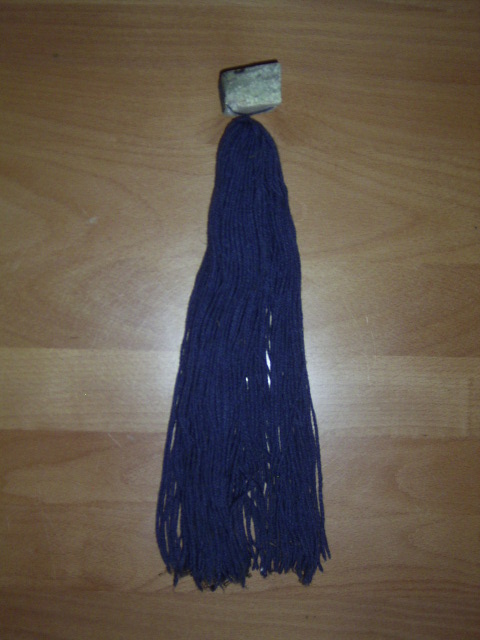 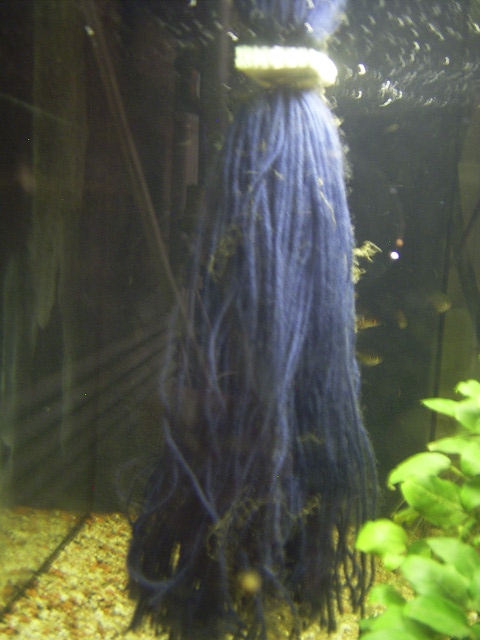
In particular on the day after a water change there will be intense spawning activities. Many species (Exception: Glossolepis)
don´t eat their eggs. After some days there will be reasonable
amounts of eggs in the mopp. The Mopp can be taken out of the Aquarium,
squeezed (don´t worry, the eggs will not be hurt) and inspected.
With some routine the tiny (1-2 mm regarding to the species) eggs can
be seen adhering to the wool threads with their sticky filament. The
clear eggs will turn a bit darker after some time and soon the eyes of
the larvae will be visible through the egg shell. After having enough
„eggs with eyes“ can be found in the mopp, or after 8-10
days, it is time to take the mopp out of the breeding tank and replace
it with a new one.
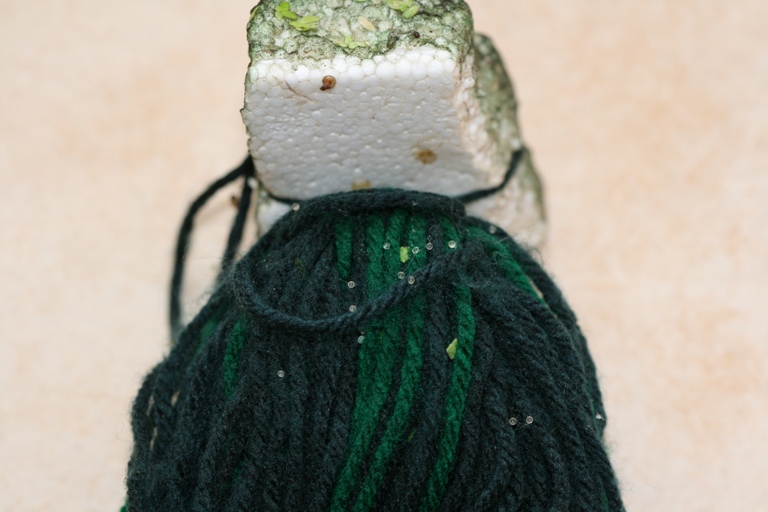 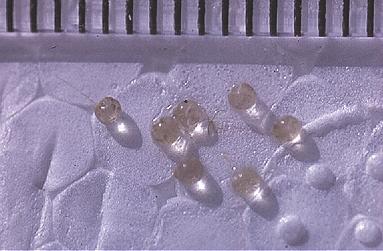 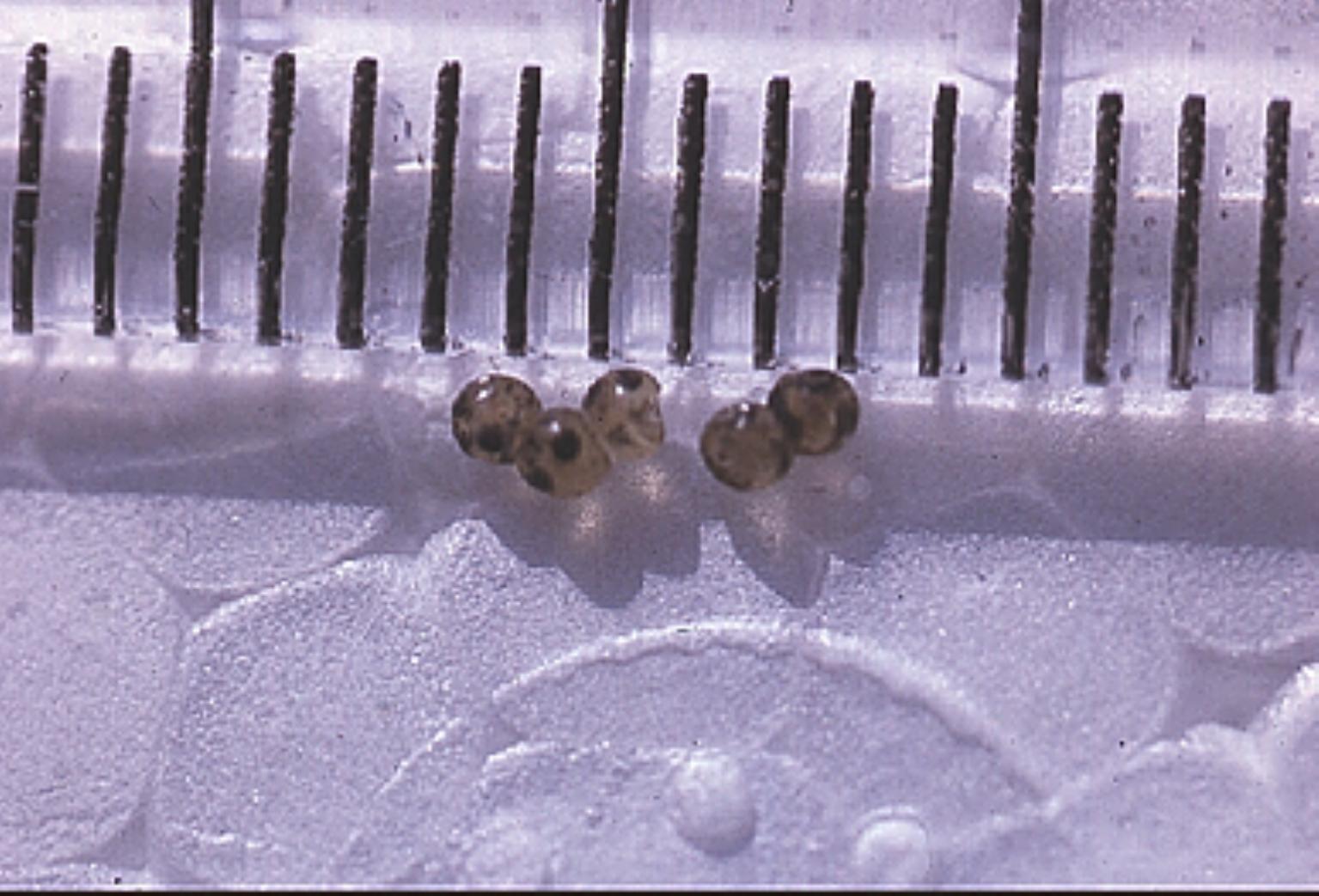
The mop full of eggs will be placed in a rearing
tank with the same water than the breeding tank. There is no need for
special care at the transfer. The eggs are robust an can be in contact
with air. But they must not dry out. The rearing tank should be
equipped with a air driven sponge mat filter with the air driven pump
regulated to not more than two bubbles per second. The larvae
can´t stand stronger currents. There will be soon the first
larvae visible at the water surface. Young Rainbowfish don´t have
a yolk sac and therefore need to be feeded from the first day. The best
food are cultures of Infusoria (Paramecium caudatum, Euglena sp.) or industrial foodstuffs with a particle size of 50 – 100 µm. No waterchanges should be done in this phase.
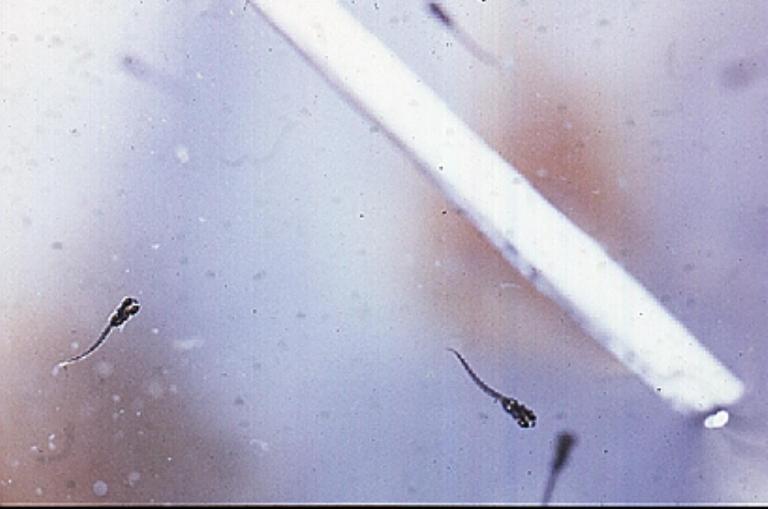
After about a week the larvae have been grown to a size that enables them to feed on Artemia-nauplii,
microworms and vinegar eels. Again, industrial foodstuffs are possible,
but can´t replace the live food completely. Now waterchanges can
be made, but carefully and in small quantities. With ongoing growth of
the fry foodstuffs can become larger.
|